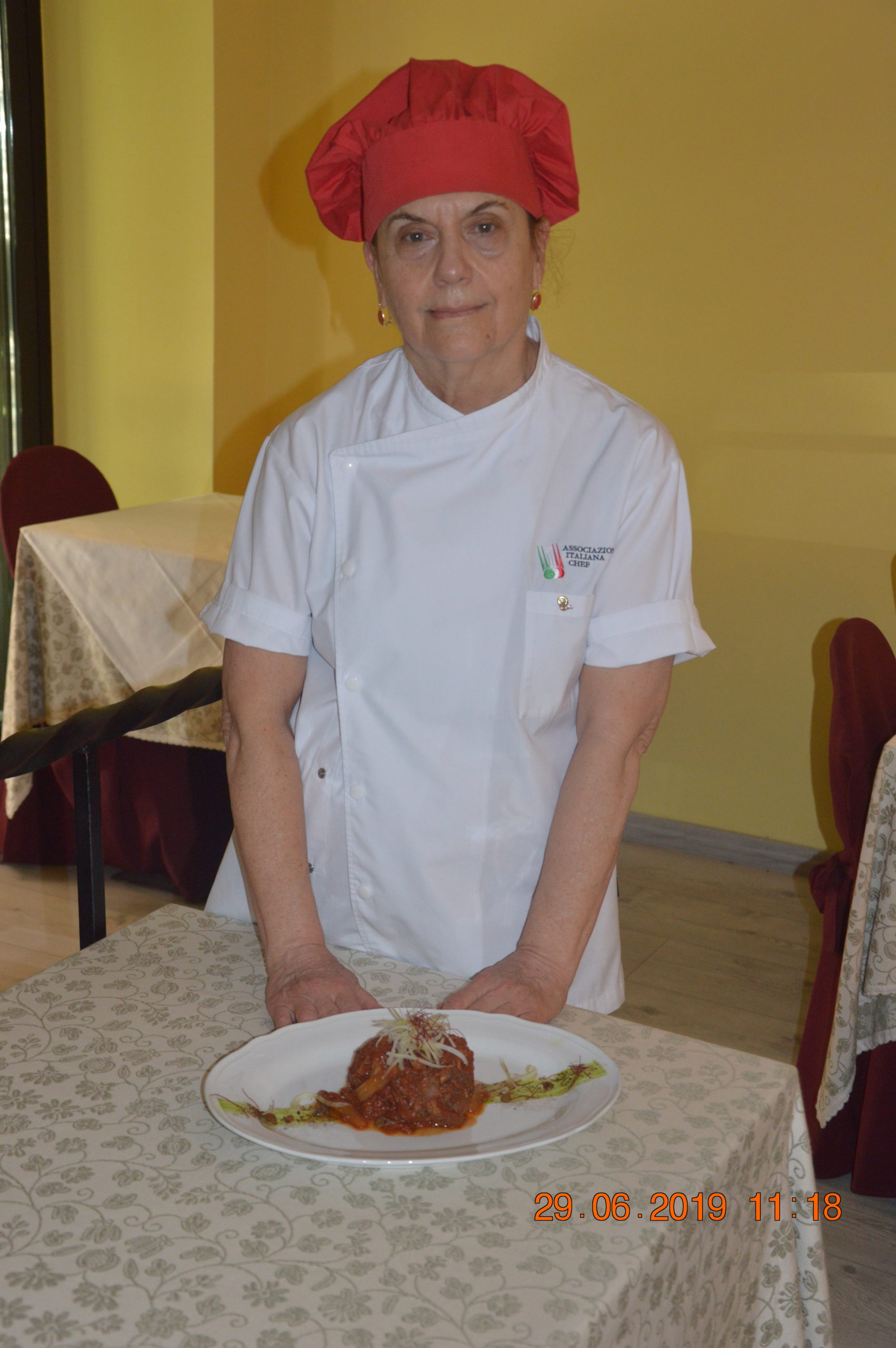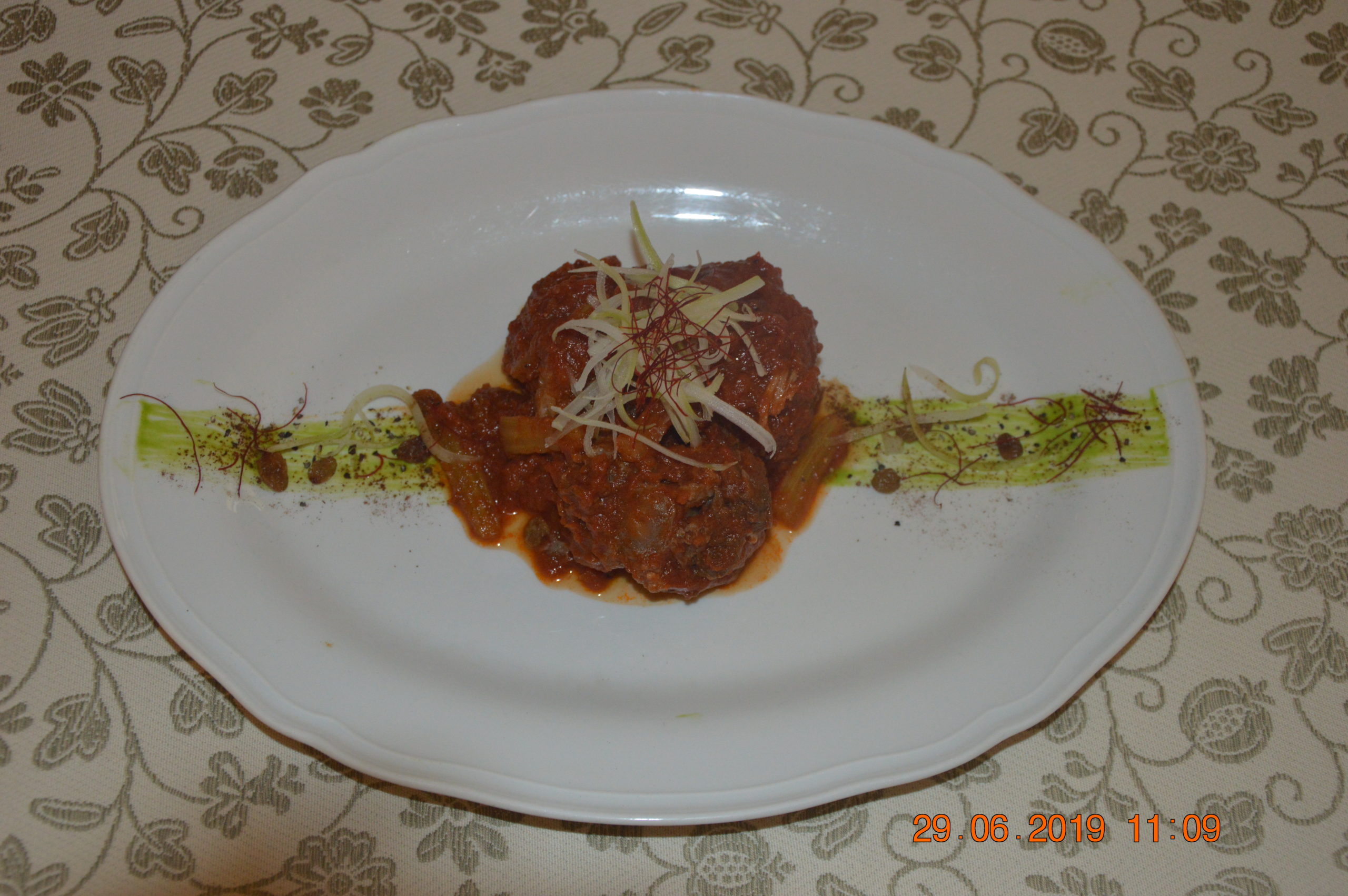
Ristorante Spirito DiVino, Rome
Via dei Genovesi 31, Rome
After 37 years as a researcher with an international career, Eliana Catalani decided to completely change her life and dedicate herself to cooking. The result was Spirito DiVino, the restaurant that Eliana runs together with her family in the heart of Trastevere. Seasonality and historic recipes are the drivers behind Eliana’s food. All her dishes are made in-house and she uses only 100% Italian extra-virgin olive oil. No GMOs are allowed, and ingredients are sourced directly from local producers or from Slow Food Presidia.
Slow Food Presidium: Piedmontese ox tail and cheek (Piedmont)
Ark of Taste: Nepi onion (Lazio)
Migrant ingredients: spices and chocolate
Cinnamon: Cinnamomum verum and Cinnamomum cassia, Lauraceae, Sri Lanka
Black pepper: Piper nigrum, Piperaceae, India
Nutmeg: Myristica fragrans, Myristicaceae, Maluku Islands
Chocolate: made from the fruit of the Theobroma cacao tree, Central America
The recipe and tradition of coda alla vaccinara are said to have originated in Rome’s Regola neighborhood. This poor working class dish is now one of the symbols of traditional Roman cooking.
So-called quinto quarto (fifth quarter), or offal, cooking developed following the unification of Italy and the building of the abattoir in front of the Monte dei Cocci between 1888 and 1890.
The tail, considered an offcut like the head, the hoofs and the innards, was given to vaccinari, tanners, and scortichini, carcass flayers, to supplement their wages.
In her book La cucina romana (1929), Ada Boni offers an initial version of coda alla vaccinara, an expression of the inventiveness and wisdom of the women of the people. In her recipe she includes not only the tail but also the gaffi, ox cheeks.
As in any popular cuisine, the variations can be never-ending. In the course of time lardo and lard have been replaced by extra virgin olive oil and/or ham fat, tomato purée has been replaced by canned tomatoes, and cinnamon, nutmeg, raisins, pine nuts and chocolate have been added, too.
Ada Boni’s recipe for coda alla vaccinara from Il talismano della felicità
Serves 6
1.5 kg ox tail and cheeks
1 tbsp lard
lardo
onion
yellow carrot
garlic
parsley
1 glass dry red wine
2-3 tbsp tomato purée
salt
pepper
celery sticks
In this recipe, the addition of the cheeks, gaffi in Roman dialect, is de rigueur.
Trim tail, vertebra by vertebra, cut cheeks into even-sized pieces and rinse thoroughly.
Put lard in a large pan with a mixture of finely minced lardo, onion, yellow carrot and parsley. Fry lightly and add tail and cheeks. Season with salt and pepper and brown all the ingredients. Pour in wine and when it has evaporated, add tomato purée. Cover tail with boiling water, lower heat and leave to simmer with the lid on. Boil celery sticks separately and cut into 6-7 cm pieces. When tail is cooked, add celery and cook together. The dish takes a long time to cook, about 6 hours. The resulting sauce should be dark, thick and tasty.
Bibliography:
Ada Boni, Il talismano della felicità, 1965, Editore Colombo, Carlo Colombo, Via di Campo Marzio, 74, Rome, pp 720-721.
Salvo Cagnazzo, Cucina, La Stampa, GEDI Digital, Published 11/10/2016
Last modification 11/10/2016 at 4.25pm.
Origins
The recipe originated in the heart of Rome, in the Regola neighborhood, where vaccinari lived in the olden days. The tail is the “queen” of the quinto quarto (fourth quarter), or offal. Other items in the category are tripe, pajata (intestine), heart, spleen and entrails. It is possible to use either a calf’s or ox tail, but the second takes longer to cook.
Tradition
There are two main versions of the dish. The first is Ada Boni’s in her La cucina romana, published in 1929. She uses the stock from the meat to make a first course and the meat itself to make a second course. The second version is richer and involves a sauce made with bitter cocoa, pine nuts and raisins.
The Secret
It makes little difference whether raisins or pine nuts or both are used. The secret of the dish lies in the hard work of removing the blood from the meat and the lengthy cooking process. Cut into pieces, the tail is browned over a low heat for about 20 minutes with mixed minced vegetables. Once the tomatoes have been added, the meat takes 2-3 hours to cook. It is ready when it starts to fall off the bone.
The Perfect Side Dish
For more traditional, old-fashioned flavors, finely chop together garlic, onion, parsley, carrot, lardo and prosciutto. Add tomato sauce and blanched celery. Allow the sauce to reduce but not too much. If necessary, add warm water.
Serves 4
8 oxtail vertebrae
½ golden onion, minced
1 kg celery
500 g carrots
1 kg canned tomatoes
750 g tomato passata
1 tbsp tomato
1 chili
½ glass dry white or red wine
salt
20 g pine nuts, peeled
50 g raisins, soaked and squeezed dry
20 g bitter chocolate, grated
30 g parsley
Brown minced onion in a little extra virgin olive oil, add tail and brown evenly. Add a pinch of salt and chili. Cut carrots and celery into round slices and add to tail. When carrot and celery start to brown pour over wine and allow to evaporate. Add canned tomatoes, passata and purée, cover with a lid and cook over a low heat for about 3 hours, stirring occasionally. Add pine nuts, raisins and chocolate, give a final stir and serve piping hot.
Anna Dente and Emilio Ferracci, Al dente come Anna, ADD Editore.
The following is a translation of a Roman dialect version of the recipe in verse written by the Cesare Simmi, the famous owner of the La Cisterna osteria in Rome’s Trastevere quarter.
It’s an easy recipe, but it’s good
For making an original dish.
Take a bit of ham fat,
A clove of garlic and a minced onion,
And chop them up together
With the oil in a skillet that’s there inviting you
To fry the lot, and when it’s golden,
Chuck in the wine. As soon as it evaporates,
Straight in with the tomatoes,
Then, one at a time,
celery, raisins, a handful
Of pine nuts and a good amount of chocolate
And while the sauce cooks
And acquires flavor over a low heat,
Along comes the tail,
Which I’ll now introduce you to.
Get your local butcher
To give you a large, fatty one,
So it’ll not only be tastier
But it’ll also release more juices in the pan;
Cut the vertebrae one from the other,
Then put them in the sauce and cook them through.
The cooking should be just right
But what counts most of all
Is that the sauce shouldn’t be too reduced
And the seasoning should be spot on.
And now the guest can sit down
At the table because the tail is ready.
Bon appetito! And while you eat
Think of cooking straight out of Fairyland!
Other variations on the theme are to be found in the recipe of Adolfo Giaquinto, a cook and journalist and the paternal uncle of Ada Boni in his La cucina di famiglia. Raccolta di ricette pratiche e consigli per ben cucinare Roma. in which he adds a pinch of cinnamon to the oxtail sauce. And in that of Carnacina and Buonassisi who, in addition to raisins, pine nuts and cinnamon, add a pinch of nutmeg.
Luigi Carnacina and Vincenzo Buonassisi, Roma in cucina, Martello Editore.
Adolfo Giaquinto, La cucina di famiglia. Raccolta di ricette per ben cucinare, Tipografia Minerva.
Ada Boni, La cucina romana, 1929, Edizioni della rivista Preziosa, Rome.
